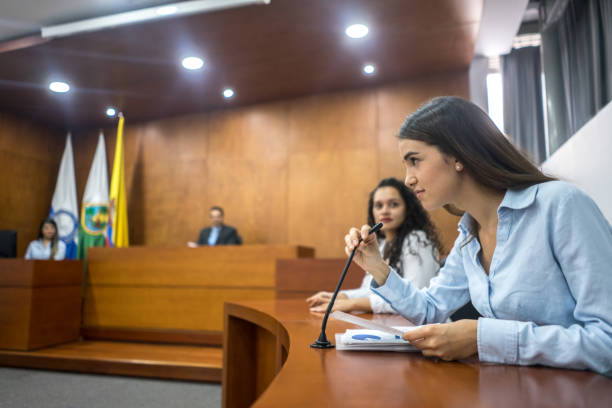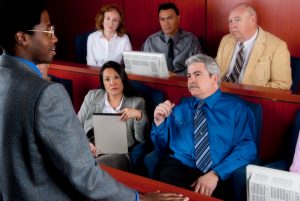Raise Your Lawful Practice with Cutting-edge Trial Presentations: Best Practices and Advice
Raise Your Lawful Practice with Cutting-edge Trial Presentations: Best Practices and Advice
Blog Article
Just How to Create Engaging Test Discussions That Gain Juries and Judges
Crafting engaging trial presentations that mesmerize courts and courts is a nuanced art that requires a tactical method. From the careful factor to consider of the audience's assumptions to the smooth integration of storytelling strategies, each component plays a crucial function in shaping the end result of a legal situation - Trial Presentations. By employing innovative aesthetic tools, integrating interactive elements, and committing time to rigorous technique and rehearsal, lawyers can dramatically boost the effect of their court room presentations. The ability to involve and convince via well-crafted discussions is an ability that can make all the distinction in winning over a jury or court, inevitably tipping the ranges of justice in one's support.
Recognizing Your Target Market
To effectively engage your audience throughout test presentations, it is vital to comprehend their preferences, assumptions, and level of know-how in the subject. By customizing your discussion to meet the particular requirements of the audience, you can improve their understanding and retention of the details presented.
Begin by researching the demographics of the audience, such as age, education and learning degree, and line of work. This details can help you gauge their familiarity with lawful procedures and readjust your presentation design accordingly. For example, a court may call for simpler language and more aesthetic aids compared to a team of lawful professionals.
Moreover, take into consideration the mental and emotional facets of your target market. Are they considerate towards certain arguments or more likely towards truths and proof? Comprehending these subtleties can help you frame your presentation in a manner that resonates with the target market on a much deeper level.
Storytelling Methods
Understanding your target market's choices and assumptions can dramatically affect the effectiveness of your test presentations, specifically when applying narration strategies to encourage and astound. Storytelling is an effective tool that can help attorneys link with discretionary on an extra psychological degree, making complex legal disagreements more remarkable and relatable.

Integrating dazzling details, personal narratives, and ornate tools can even more improve the storytelling experience, maintaining the audience engaged and spent in the end result of the case. By crafting a convincing story that reverberates with the values and emotions of the court and courts, legal representatives can increase the chances of winning their arguments and attaining positive verdicts.
Aesthetic Presentation Devices
Utilizing visual presentation devices can considerably improve the impact and effectiveness of trial discussions by supplying a visually interesting method to see this page communicate complex information to juries and judges. Visual aids such as graphes, animations, charts, and representations can help simplify complex details, making them more understandable and available to the target market. By including visual aspects into test presentations, attorneys can create an engaging story that resonates with jurors and leaves a lasting perception.

Including Interactive Aspects
Integrating interactive components right into test discussions can boost audience engagement and understanding, cultivating a much more interactive and immersive courtroom experience. By incorporating aspects such as interactive timelines, 3D computer animations, clickable displays, and virtual truth repairs, attorneys can captivate courts and jurors, making complicated details a lot more advice unforgettable and available.
Interactive timelines allow for a vibrant display screen of sequential events, assisting the target market comprehend the sequence of key events in an instance. 3D computer animations can bring criminal activity scenes or mishap restorations to life, supplying a thorough graph that helps in clearing up complex details. Clickable exhibits make it possible for individuals to engage with evidence, records, or pictures, allowing for a hands-on exploration of important info.
Additionally, online reality restorations can move the target market into the heart of the activity, giving a compelling viewpoint that traditional discussions might do not have. These interactive components not only involve the visitors yet likewise empower them to proactively take part in the trial process, leading to a much more impactful and persuasive court room presentation.
Practice and Rehearsal
To effectively utilize the possibility of interactive aspects in trial presentations, thorough practice and rehearsal are vital to make sure seamless combination and delivery in the court setting. Technique and practice session help trial presenters become accustomed to the content, timing, and flow of their presentations, allowing them to confidently browse with different elements such as video clips, animations, or interactive graphics. By rehearsing their distribution, speakers can refine their speaking skills, body language, and general presentation style to improve persuasion and reputation prior to the jury and court.
During session, speakers can determine any technical problems that might arise with interactive components, ensuring that whatever runs efficiently during the actual test. Additionally, rehearsing before a simulated audience or associates can provide beneficial feedback on the effectiveness of the interactive components and the total discussion. This responses permits presenters to make essential changes and enhancements prior to entering the courtroom, ultimately boosting the influence and success of their test presentations.
Verdict
In verdict, producing engaging test click to read more presentations that captivate judges and courts calls for a deep understanding of the audience, effective storytelling methods, aesthetic tools, interactive components, and detailed practice (Trial Presentations). By applying these techniques, attorneys can efficiently convey their disagreements and evidence in a compelling way that resonates with the decision-makers in the courtroom
Making use of aesthetic presentation tools can substantially boost the effect and efficiency of trial discussions by providing an aesthetically appealing way to communicate complicated details to courts and courts. By including aesthetic components right into test discussions, lawyers can create an engaging narrative that reverberates with jurors and leaves a long-term perception.
One popular visual presentation device is the use of multimedia discussions, which permit for the integration of videos, photographs, and audio recordings to supplement spoken arguments. Trial Presentations.To effectively take advantage of the potential of interactive aspects in test discussions, thorough technique and rehearsal are crucial to make sure smooth assimilation and distribution in the court room setting. Practice and wedding rehearsal assistance test speakers come to be familiar with the content, timing, and circulation of their presentations, permitting them to confidently browse through different elements such as video clips, computer animations, or interactive graphics
Report this page